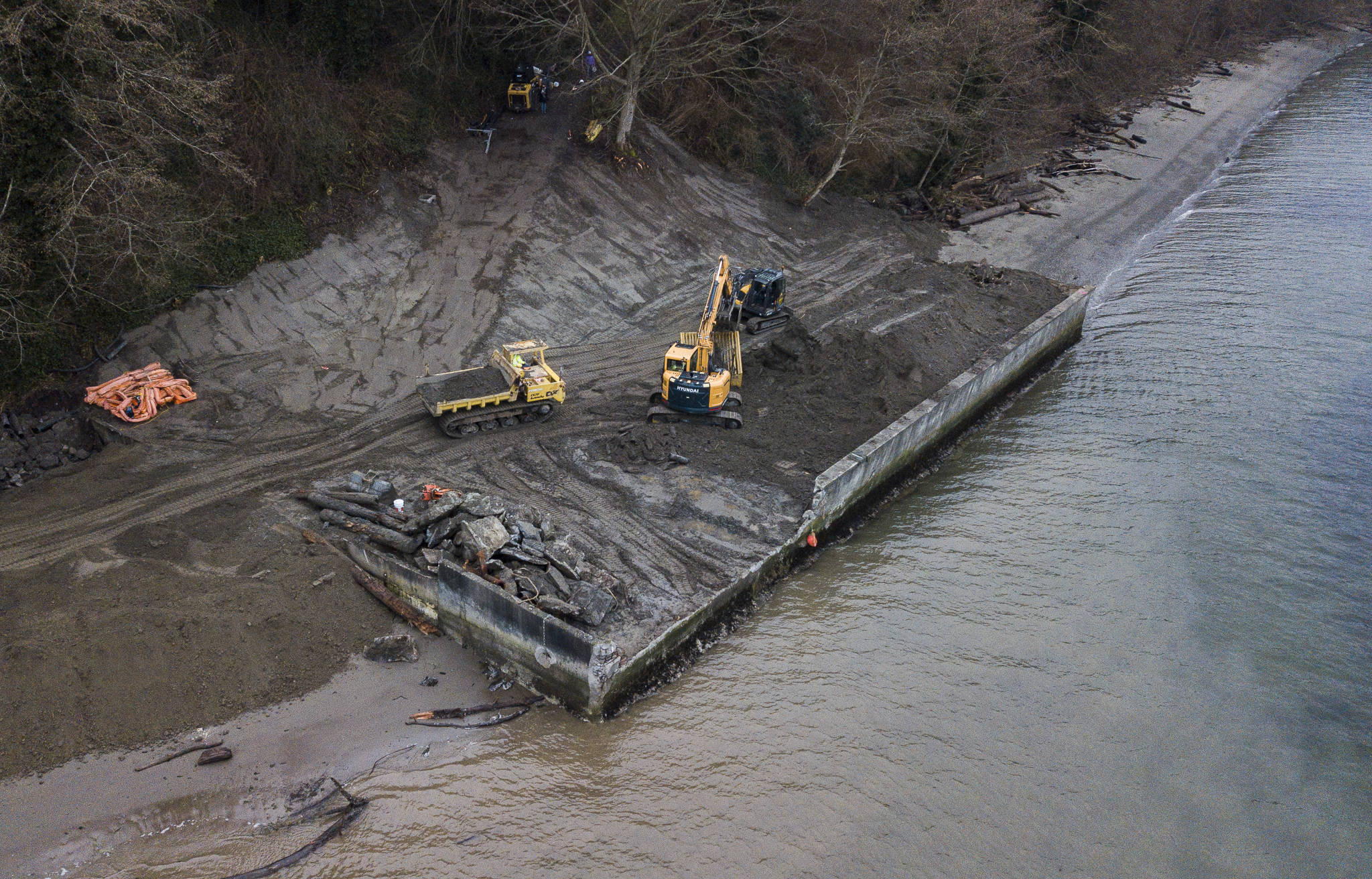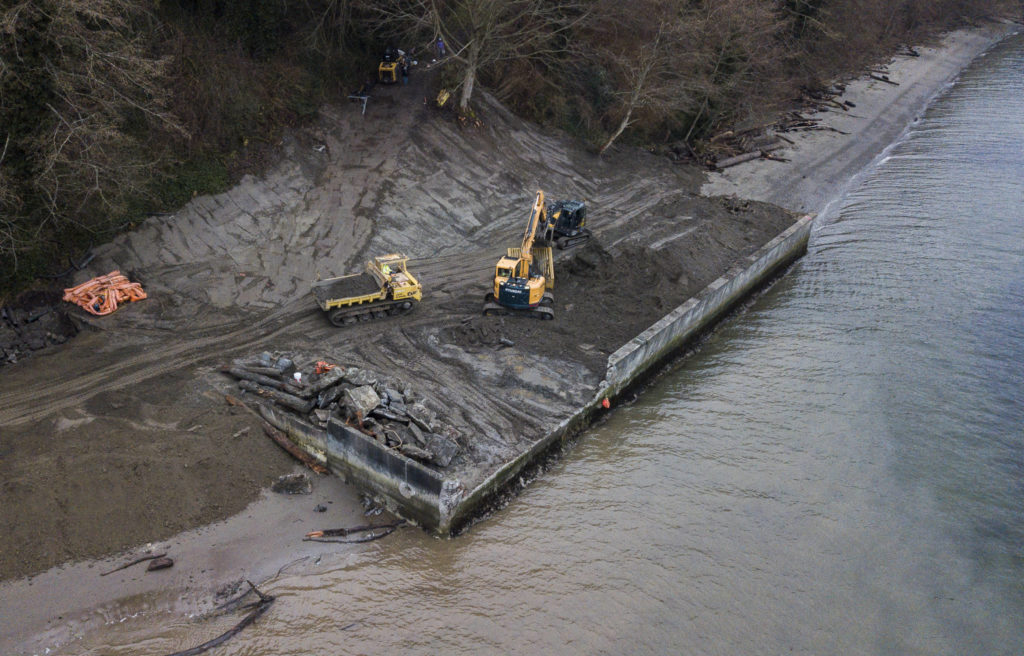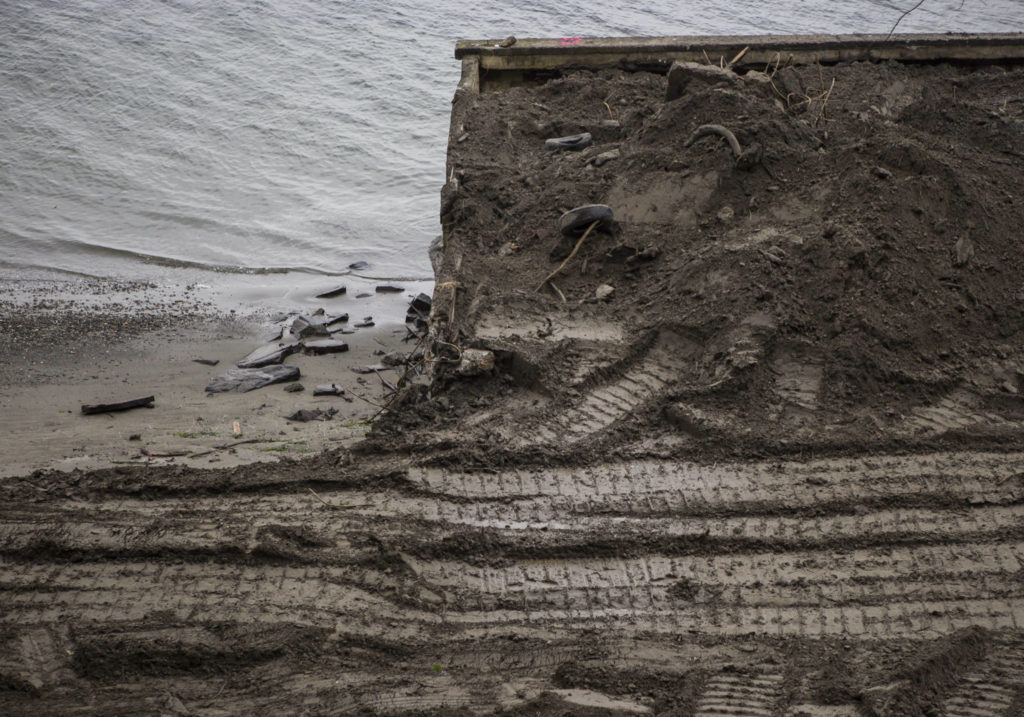COUPEVILLE — Island County doesn’t need a canary in the coal mine to warn of advancing climate change. It already has sand lance and surf smelt.
The small fish are silvery links in the chain of Puget Sound life, eaten by many marine animals. They can’t survive without beaches and shallow water. Both habitats are in short supply because humans have armored shorelines with boulders, concrete bulkheads and dikes. Climate-driven sea level rise and storm surge can only make matters worse, said Lisa Kaufman, nearshore program manager for the Northwest Straits Foundation.
“Usually, bulkheads are sitting right on top of where forage fish spawn,” she said. “As sea levels rise, it will get deeper and deeper and there’s not going to be a beach.”
Restoring shorelines to their natural state can protect waterfront homes as well as fish. But even Island County residents without million-dollar views may find climate change at their figurative doorsteps. That could be because they pay taxes, drink water, run a government, serve in the Navy, serve shellfish, guide tourists. Or perhaps they simply thrill at the sight of endangered orcas — which eat endangered salmon, which eat sand lances and smelt.
Climate change concerns have made their way into public debate and county documents, notably this year’s expected updates of the Shoreline Master Plan and Hazard Mitigation Plan.
The latter, available in draft form on the county’s Emergency Management website, takes climate change into account with its assessment of hazards ranging from coastal erosion to earthquakes. The authors conclude that “the entire population, structure, economy and natural resources of the area will be impacted by climate change in some form.” Among the potential threats they list: Greater risk of wildfire. Deeper, more extensive floods. More severe storms and droughts. Stress on groundwater supplies.
Even islanders not focused on climate change may remark on the nearly frostless winters or the sight of pelicans that have started showing up in Deer Lagoon. The big birds, like some people flocking to the Northwest, are migrants from hotter places.
Island County is made up of two long islands, Whidbey and Camano. No part of it is more than three miles from saltwater. With 196 miles of shoreline to oversee, county officials commissioned a Sea Level Rise Strategy Study. The findings will be incorporated into the Shoreline Master Plan.
Much of the University of Washington study was based on the research of Ian Miller, a coastal hazard specialist with Washington Sea Grant. When Miller gives Island County presentations, the meetings are well-attended. Many in the audience are shoreline property owners.
Their most pressing questions: How high will the water rise? And by when? Miller has no solid answer. The great unknown is how fast polar ice caps melt. Ballpark figures included in the Island County study are a rise of 1 foot by 2050, 1.7 feet by 2070, and 3 feet by 2100. The figures get less reliable at mid-century and don’t factor in the reach of storm-driven waves.
“My job has been trying to convince people that it’s something we should be planning for,” Miller said, adding that the impacts of sea level rise will be felt within the lives of young people and the time span of mortgages. He encourages communities to think not just about houses, but also roads, access to emergency services, pipelines and power lines.
“Island County has low-lying areas that are developed, eroding bluffs that are developed,” Miller said. “It’s exposed to wave energy, especially the west-central side of Whidbey Island.”
That part of the Whidbey coast was the scene of the massive Ledgewood Beach landslide in 2013, which pushed one home into the sound and led to 65 lawsuits against the county over poor drainage on the bluff. The county settled without admitting liability. The incident cast a spotlight on taxpayer, as well as property owner, vulnerability. There was a similar landslide in January 2021 near Possession Point, though no buildings were affected.
Some island homeowners have gone so far as to move their homes back from the bluff or shoreline. There are also less drastic options, what Miller calls “lots of low-hanging fruit.”
The county sea level rise report includes best practices for stabilizing bluffs, flood-proofing homes and protecting septic systems from saltwater intrusion. Options are ranked by effectiveness and cost. Planners intend to use the information with the public, including people who apply for shoreline permits.
None of the options, Miller cautioned, “allow homeowners to sit back and enjoy their property the way they’ve enjoyed it forever.”
Come high water
Camano Island resident Wally Costello took that message to heart when he heard Miller speak in 2019. Costello and his wife, Shila, were on the verge of replacing the old barged-in military house that had served as their vacation getaway for 25 years. After learning more about sea level rise, they decided to build their retirement home two feet higher. They live at the Maple Grove Road and Scenic Avenue intersection, which, along with a neighbor’s house, floods regularly. Costello can’t attribute that to sea level rise but said destructive storms are ramping up.
“There was a big event on Sept. 17, 2012, another in 2016. Now we’ve had one on Nov. 13, 2020, and this recent one on Jan. 13,” said Costello, who keeps an eye on the barometric pressure. “If the barometer takes a big dip when there is a high tide, the actual water level will be much higher than predicted.”
County Commissioner Janet St. Clair lives nearby. The Maple Grove intersection is among the Camano flooding hotspots that she checks on after big storms. St. Clair has a long-time interest in climate change. She is especially concerned about its impact on the island’s small farms and endangered orcas, and the tourism economy that is boosted by both.
Flood-damaged roads may be the biggest threat, she said. The county is fortunate that most of its water supply comes from aquifers, she said, so it’s not dependent on runoff from dwindling mountain snowpack.
St. Clair is pleased that the county recently landed a Northwest Clean Air Agency grant to update an 11-year-old study of greenhouse gas emissions, which are the main driver of human-caused climate change. In addition to emission sources such as buildings, the study will look at the impacts of land use.
The research updates may lead to new county rules, St. Clair said, though “our approach in government has been to educate and advise. Regulatory standards are the last option.” With a nod to the challenges ahead, the Democrat added: “I don’t think the general public wants to politicize this issue.”
The biggest city
Island County’s population is approaching 87,000. With 23,000 residents, Oak Harbor is the largest city. That is due in large part to the presence of Naval Air Station Whidbey, home to Growler squadrons. While the jets scream overhead, base officials are paying attention to climate change threats on the ground.
A 2017 Department of Defense report identified installations facing potential effects of climate change. It didn’t mention NAS Whidbey, but as regulations require, new facilities there have been designed to reflect climate reality. According to base spokesman Michael Welding, the Navy has updated and overseen construction of aircraft hangars, aircraft stimulators and an unmanned aerial vehicle station on the island. All but the hangars were built on higher ground.
Environmental staff have analyzed the impact of a 2-foot sea level rise, Welding said, and determined that it would not affect base operations. He noted that the base has reduced greenhouse gas emissions by 27% in the past seven years. Energy use at base facilities has dropped 47% since 2003.
On the civilian side, workers are putting the finishing touches on Oak Harbor’s most expensive investment ever, a $150 million state-of-the-art wastewater treatment facility. Mayor Robert Severn takes pride in the purity of the water that the plant releases into Puget Sound.
“Our citizens are paying higher rates as a result of that. It saves shellfish and salmon,” he said.
The facility is in the coastal floodplain, where the old one was. City officials decided against an alternative site that was two miles from the rising sea.
“It would have meant collecting waste at the present site, pumping to the other site, treating, and then pumping back down for outflow into Oak Harbor Bay,” Severn said. “We figured annual pumping costs would have been over a quarter million dollars a year.”
Instead, he said, the facility was designed to cope with higher water.
Bob Hallahan is keenly aware of the decision. As head of the Whidbey Island Chapter of the Citizens Climate Lobby, he sees climate change impacts all around.
“All winter long, we’ve had barely a frost here in Oak Harbor. It’s not that long ago that Pass Lake and Cranberry Lake were frozen, and people were ice skating there,” he said.
Climate change is not an issue that has taken off in local imaginations, Hallahan said. When he met with the mayor and city executive a couple years ago, he said, they were polite but distracted.
“Oak Harbor is very interested in economic growth, and it just hasn’t caught on the way I would hope,” he said.
As an example of climate-related problems, he mentioned that Mariners Cove is at risk from rising water.
Mariners Cove, one of three canal communities on Whidbey Island, was built for boaters on fill land in the 1960s. Paul Belanger moved there two years ago. He is water commissioner for the homeowners association, which plans to dredge the canals soon.
“This is probably the last dredge they have to worry about, because they’ll be inundated after that,” Belanger said. “I’m in a new home 40 feet above that, but I’m tied to the HOA, so it affects my home value.”
Belanger is a geologist and paleoclimatologist who spent his career either teaching or working in the oil and gas industry. Since retiring a decade ago, he said, he has been fighting climate change, hoping to get industry colleagues to acknowledge the damage done by fossil fuel emissions. Last year he joined the board of Sound Water Stewards, an environmental education group formerly headed by county Commissioner St. Clair.
“I’ve taught a lot about Earth climate past and present, concerns and solutions,” Belanger said. “This is a crisis, but there are solutions out there. Where does pessimism get you?”
Threats from the sea
Penn Cove Shellfish, headquartered in the county seat of Coupeville, may be Whidbey Island’s best-known business. Ian Jefferds has been owner-manager since 1975, overseeing the farming of manila clams, oysters and mussels. With widespread closure of restaurants, his industry has been hit hard by the coronavirus pandemic. But it already has adapted to another global crisis. That one showed up in shellfish hatcheries in the form of fatal bacterial infections.
In 2008, Jefferds said, farmers learned that the real problem affecting the growing shellfish was human-released carbon dioxide. After building up in the atmosphere, it has been increasingly absorbed by the oceans. That makes the saltwater being pumped into hatcheries more acidic. Acid stifles the creation of the calcium carbonate that shell-growing creatures need.
Hatchery managers now monitor water intakes when they are trying to spawn and set shellfish. They buffer the water with sodium carbonate to help young shellfish survive.
“I wouldn’t say it’s fixed. It’s an ongoing adaptation,” said Jefferds, who pairs a scientific vocabulary with business instincts. “If they cut off all of the carbon dioxide output in the world today, it’s a problem that will continue for the next hundred years.”
Down the coast, pandemic restrictions have limited visiting hours at the Langley Whale Center, home base for the Orca Network. But when tourists are again free to flock there, they may see a new display focused on climate change.
The Orca Network is working with other marine science centers to agree on a climate change message and pool resources to share information, said Amanda Colbert. She is education and events assistant for the network and occasional docent at the Whale Center.
“Climate change comes up as one of the things threatening both species,” she said. “It is impacting salmon (availability) for orcas. And our gray whales are experiencing some sort of food shortage in the Bering Sea. … In a three-year period, there’s been a massive die-off of gray whales.”
Back to nature on the coast
Just north of Langley, the Northwest Straits Foundation is working to boost the salmon food supply. It is restoring habitat for those nutritious surf smelt and sea lances, first by removing a barge that extended 136 feet along the shore and 98 feet into water. Installed in the 1960s by Seahorse Siesta subdivision homeowners as a seaside lawn, it was deteriorating and becoming a safety hazard.
The Foundation works in seven counties, partnering with governments and landowners to remove artificial armoring or avoid it altogether. Landowners come looking for technical assistance and advice, said Kaufman, the program manager.
“A percentage of people just want to do the right thing for the environment,” she said. “Most are driven by concerns about erosion of the shoreline. If they don’t already have a bulkhead, they wonder if that’s their only option.”
Property owners also turn to the county’s Department of Natural Resources for advice and for small grants to help stave off erosion of bluffs and shorelines. Anna Toledo, a watershed planner, hears such questions as, “Now I’m getting a storm every year, how can you help me?” and, “What should I be doing to prepare for sea level rise?”
Unfortunately, she said, natural restoration can’t protect sites that are subject to high-energy waves. There is still work for people who place boulders and bulkheads. When the county’s Shore Friendly program placed a legal ad inviting such contractors to a meeting, it caught the attention of Vivian Stembridge.
Stembridge and her husband have lived in Sunlight Shores, on southwest Whidbey, since 1983. At every annual meeting of homeowners, they would hear how the 350-foot bulkhead along the community beach was deteriorating but there was no money to fix it. So when Stembridge learned about the contractors meeting, she called Toledo to ask if she could attend.
Ironically, in a room full of hard-armor professionals, she learned that grant money was available and permitting fees would be waived if her community took the “soft armoring” approach. The homeowners board approved, and work started in 2018 with help from the Northwest Straits Foundation. Out came the bulkhead and creosote pilings.
Kaufman is delighted with the results. She credits the community with watering and weeding the newly planted native vegetation.
As a project bonus, Sunlight Shores residents have better access to their waterfront.
“Before, getting to the water’s edge was very difficult because you had to scramble over boulders, pilings and concrete rubble to end up on a mud flat,” Stembridge said.
Now people can stroll onto a cobbly, sandy beach. One where sand lances have room to move as the water rises in Puget Sound.
Julie Titone is an Everett writer who can be reached at julietitone@icloud.com. Her climate change reporting is supported by the Herald’s Environmental and Climate Reporting Fund.
A new way to support local journalism
This article is made possible by contributions to The Daily Herald’s Environmental and Climate Change Reporting Fund, part of an effort to find new ways to help pay for the local journalism that is essential to a vibrant community.
The fund, established in cooperation with the Community Foundation of Snohomish County, provides an opportunity to make tax-deductible donations to help support environmental and climate change journalism in The Herald newsroom.
This latest grassroots initiative already has drawn support from the League of Women Voters of Snohomish County, the Washington State Sierra Club and 350 Everett, a climate action group. We’re pleased to have their backing as we seek new resources to help us cover topics that are important to our readers.
The Daily Herald maintains editorial control over content produced with fund resources.
To donate to the fund, please go to www.heraldnet.com/climatefund.
Talk to us
> Give us your news tips.
> Send us a letter to the editor.
> More Herald contact information.




























